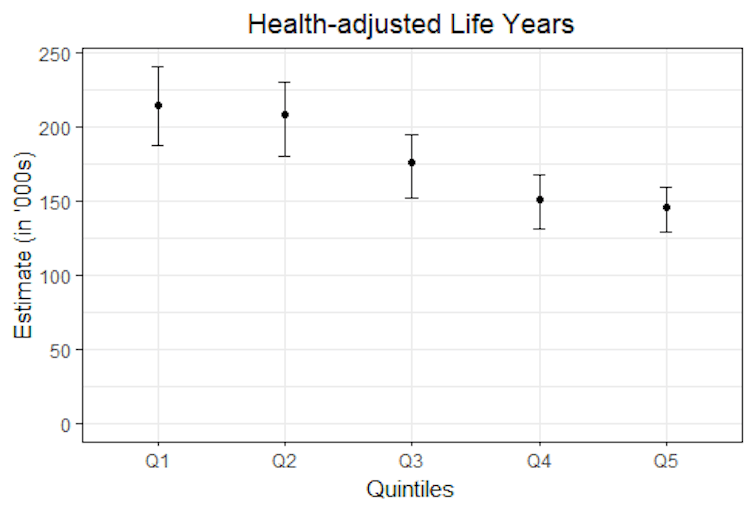High blood pressure is a “silent killer” because the symptoms often don’t show until the person develops complications such as stroke or heart attack. It is pervasive in Indonesia and the prevalence is on the rise.
As of 2018, one out of every three Indonesians aged 18 years and above – and up to half of Indonesians over 40 – have high blood pressure. That’s up from one in four affected adults half a decade earlier.
High blood pressure has been linked to unhealthy diets, especially those high in sodium.
The World Health Organisation recommends we should consume no more than 2000 mg of sodium (or 5 grams of salt) per day. That’s about one teaspoon a day. Also, we should consume at least 3510 mg of potassium per day. Insufficient potassium intake, driven in part by diets low in fruits and vegetables, increases the risk of high blood pressure.
However, a national food consumption survey in Indonesia found that on average, more than half of the population eats above 5 grams of salt per day. Another study shows practically no-one is consuming the recommended amount of potassium.
In the 2023 WHO global report on hypertension, salt substitutes with reduced sodium and added potassium are highlighted as an affordable strategy to tackle high blood pressure. A recent overview of randomised controlled trials has shown these salt substitutes are effective in reducing blood pressure and deaths from heart disease and stroke.
Our study, published in The Lancet Regional Health – Southeast Asia, estimated the likely benefits of a simple switch from regular salt to low-sodium potassium-enriched salt substitute alternatives.
What did we do?
We developed a simulation model to estimate the potential long-term impacts of a government-led policy in which regular salt containing 100% sodium chloride was progressively replaced with salt substitutes. These substitutes would contain 75% sodium chloride and 25% potassium chloride.
The replacement applied mainly to salt used in the home for cooking and seasoning. It was gradually rolled out over five years to attain coverage levels similar to the percentage of households consuming iodised salt in Indonesia.
Health benefits were estimated overall, and across income quintiles of the population. We also estimated the likely cost of the policy to the government, and whether it offered value for money.
Impact of salt substitutes
In our model, after 10 years of implementation, the switch from regular salt to low-sodium potassium-enriched salt substitutes could prevent over 1.5 million non-fatal cases of heart attack and stroke. It would also prevent 643,000 new cases of chronic kidney disease in Indonesia.
In addition, over 200,000 deaths from heart disease, stroke and chronic kidney disease could be averted or postponed.
Our model showed that over 880,000 health-adjusted life years would be gained in ten years, and up to 24.6 million health-adjusted life years over the lifespan of the Indonesian population. That’s about 92 healthy life years gained per 1,000 people. A health-adjusted or healthy life year is equivalent to one year of life in good health.

Those in the lowest income bracket had about 1.5 times more health gains than their wealthiest counterparts. This was mostly because poor people in Indonesia have comparatively higher average blood pressure.
Considering program development, implementation and salt reformulation, this salt switch policy would cost approximately US$ 2.1 billion (about IDR 29.7 trillion) over 20 years.
However, these costs are significantly outweighed by the savings accrued from reduced health expenditure, estimated at about US$7.3 billion (about IDR 103.2 trillion) over the same period.
Modelling analyses from China and India have also reported large health gains. In Cameroon, Vietnam and New Zealand, the use of salt substitutes would also be a cost-saving strategy to address high blood pressure and its consequences.
What does this mean for Indonesia?
The World Health Organisation has called for countries to reduce their salt intake by 30% to control noncommunicable diseases – a policy endorsed by the Indonesian Ministry of Health. But many countries, including Indonesia, are not on track to achieve this goal.

Salt and salty flavours are a key component of the local Indonesian cuisine. Thus, reducing salt consumption is a huge cultural challenge.
For Indonesia and other countries where most of the sodium in the diet is from salt added during cooking, replacing regular salt with salt substitutes can help people effortlessly reduce their sodium consumption and simultaneously increase potassium intake.
These salt substitutes also look and taste similar to regular salt, enhancing their acceptability.
Money-wise, more than half of the burgeoning national health expenditure in Indonesia is from noncommunicable disease, predominantly stroke and heart disease.
The Indonesian government should therefore consider reformulation of regular salt to potassium-enriched alternatives. It should facilitate supply chains nationwide to enhance their availability and affordability, in its package of strategies to prevent and control chronic diseases.
A salt switch policy will help reduce pressure on the health system due to fewer cases of heart attack, stroke and kidney disease. It would also provide much-needed health expenditure savings.

